

WARNING! The Sun is extremely dangerous. Looking at it
with any sort of optical aid will result in instant blindness.
Look here to
see how I do it.
The Sun has been quiet in that there have been no significant spots since the middle of 2008. This is an unusually long time. During that time there have been a few very small spots of both the old and the new cycle, but none that I felt I could image with any success. The last spot I imaged was number 10989, and the one below is 11035, so there have in fact been 46 spots I have missed during that time. 46 spots in nearly 19 months!
It is a characteristic of sunspot cycles that, at the beginning of the cycle, spots appear at high latitudes and gradually move towards the equator as the cycle passes through its 11-year period, the last spots appearing near the equator.
Move your mouse over the pictures below to see the number designations of the spots.
|
Sunspot Designations |
Sunspots and Active Regions are numbered by the American National Oceanic and Atmospheric Administration (NOAA) and started on 5th January 1972. These numbers now exceed 10000 but often the first or the first two digits are omitted. The designations of current sunspots can be found on the SOHO site. A most useful archive of diagrams of the Sun showing the positions and designations of sunspots on a daily basis right back to January 1992 is available from The Institute for Astronomy, University of Hawaii. This link will take you to their archive page from where you can select a given image by date or browse by month. I find this particularly useful if I have imaged an interesting spot after some days of cloud, and I can look back and see when the spot appeared. |
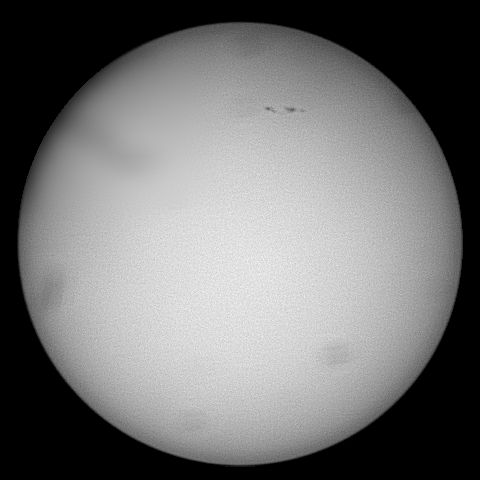
|
This is a poor picture. I shouldn't make excuses, but the imaging had to be done in very difficult circumstances. The Sun, at this time of year, is very low in the sky and not only was I contending with clouds but also with neighbouring trees and a camera not as clean as it should have been. I had only just discovered that there was a significant group of spots on show and we had an unexpected clear morning, so it was all done in a rush. However I felt the presence of the first decent group of the new cycle 24 warranted a picture if I could possibly manage it. The pictures were taken with a 270mm SLR lens attached to an Atik 1-HS camera. This group is at latitude 40° north, although it looks further north in this picture. This is because the rotational axis of the Sun is not vertical in this picture; it is difficult to know just where it is, but the camera was aligned with the axis of the telescope. Date and Time: 17 December 2009, 12:05 UT Camera: Atik 1-HS Telescope: 270mm SLR lens at f/5.6 Capture: K3CCDTools. Low gamma, 1/500", 9% gain, 105 frames Processing: Registax. 33 frames stacked. Wavelets 1-2 = 10, histogram 0-155 |
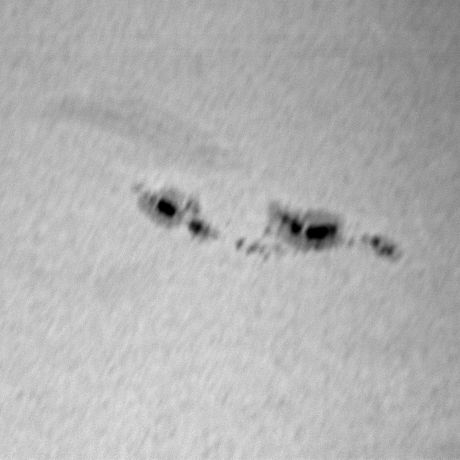 |
Close-up of spot number 11035. The picture was taken with the Atik 1-HS camera at the prime focus of my ETX125 Date and Time: 17 December 2009, 11:47 UT Camera: Atik 1-HS Telescope: ETX125 at prime focus Capture: K3CCDTools. Low gamma, 1/1000", 0% gain, 805 frames Processing: Registax. 272 frames stacked. Wavelets 1,2 = 10, gamma 0.8, histogram 65-205 |
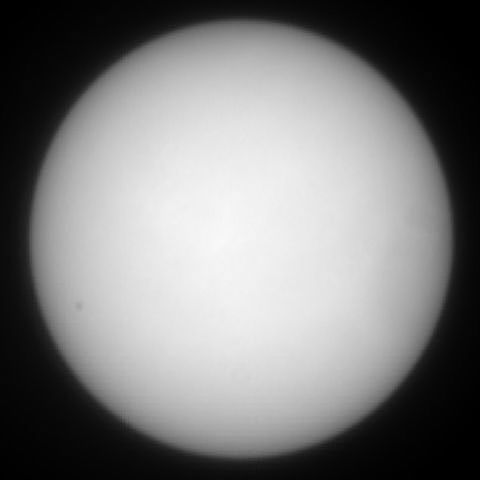
|
This is spot number 11084, so there have been 49 others since the one I pictured above. These have been small and I have neglected the Sun through the winter and spring. However this one was just visible in binoculars (I have some protected with solar film), so I decided it was worth a shot. This picture is experimental. In the past I have used a ToUcam (the Atik I used above is a ToUcam with a different CCD), but this time it was more convenient to use my MX716, which I have piggybacked on my LX200 and will take the same SLR lens. This camera is really far too sensitive and, with only an IR-block filter in addition to the solar filter, required an exposure of only 0.002 second. So I added each of my narrow-band filters mainly to reduce the light but also to see what difference it made. This picture was taken through the OIII filter as the best picture (click on the image to see them all). The picture was smaller than I get with the ToUcam (I assume this means the pixels are smaller as well as the CCD being larger) so I have magnified it here by a factor of 1.5 to make it look the same size as the picture above. The spot is in the southern hemisphere at about 20° south. Date and Time: 28 June 2010, 11:37 UT Camera: Starlight Xpress MX716 Telescope: 270mm SLR lens at f/4 Capture: star_mx7. Low gamma, 0.05", 40 frames Processing: Registax. 40 frames stacked. Wavelets 1-2 = 10, histogram 42-255 |
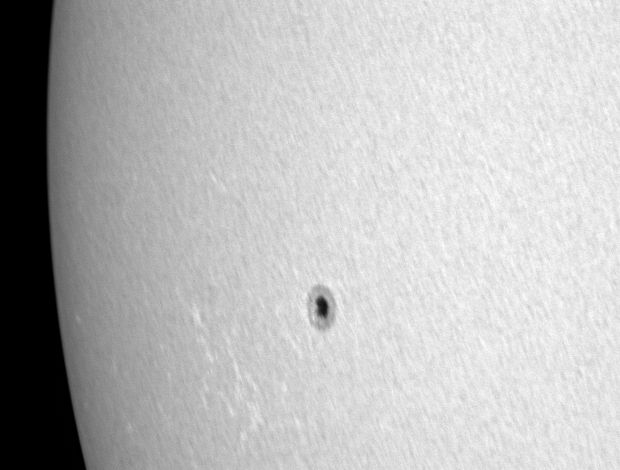 |
Close-up of spot number 11084. The picture was taken with my DMK camera at the prime focus of my ETX125 Date and Time: 28 June 2010, 13:37 UT Camera: DMK 21AF04 Telescope: ETX125 at prime focus Capture: ICCapture. Gamma 10, exposure 1/1477 sec, gain 577, 4282 frames Processing: Registax. 150 frames stacked. Wavelets 1,2 = 10, histogram 0-210, gamma 0.8, |
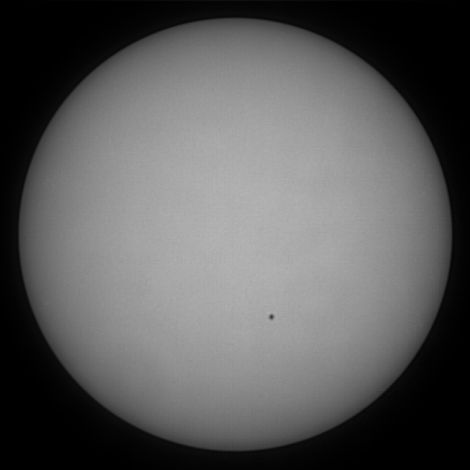
|
This is spot number 11084 again, but a much better picture, taken with my DMK camera Date and Time: 3 July 2010, 06:48 UT Camera: DMK 21AF4 Telescope: 270mm SLR lens at f/5.6 Capture: ICCapture. Exposure 1/108 sec, gain 264, 5017 frames Processing: Registax. 201 frames stacked. Wavelets 1-2 = 5, histogram 10-255 |
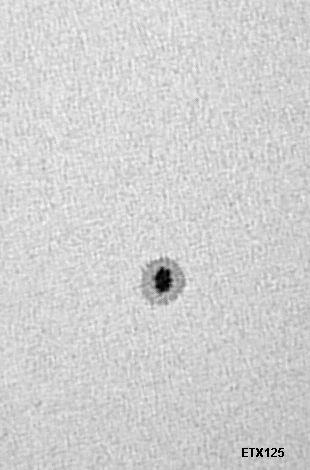 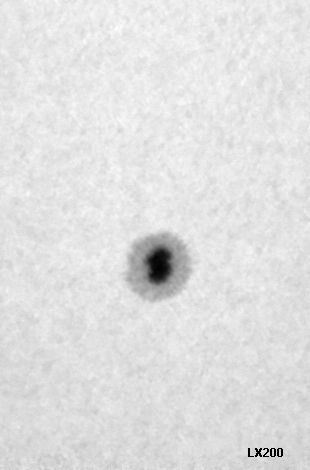 |
Two close-up pictures of spot number 11084. Both pictures were taken using my DMK camera. The one on the left was taken at 08:37 UT at the prime focus of my ETX125; The one on the right was taken at 14:21 UT at prime focus of my LX200 with a full-aperture solar filter made from Baader Astrosolar film. So the pictures are almost 6 hours apart. It almost looks as though the spot may be splitting into two. Or is it? (Note that the difference in size is caused by the longer focal length of the LX200.) Date and Time: 3 July 2010, 08:37 and 14:21 UT Camera: DMK 21AF04 Telescope: ETX125 and LX200 at prime focus. Capture: ICCapture. ETX125: gamma 10, exposure 1/736 sec, gain 250, 3028 frames LX200: gamma 10, exposure 1/1241 sec, gain 180, 3398 frames Processing: Registax. ~140 frames stacked, wavelets 1,2 = 10, histogram as appropriate, Focus Magic 4,75 |
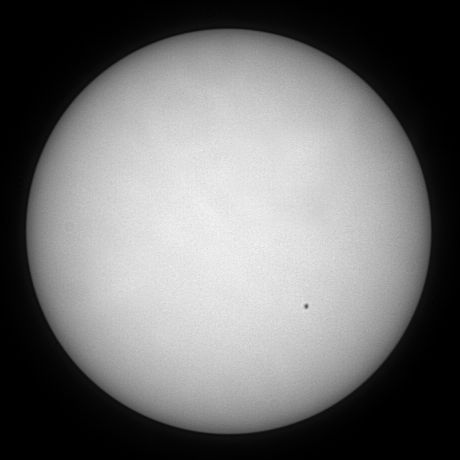
|
This is spot number 11084 again, but another much better picture, taken with my DMK camera. If you move your mouse pointer over the image, you will see a superimposition of this image over yesterday's. The change in size was caused by my having a slightly different distance between my lens and the camera. Date and Time: 4 July 2010, 07:03 UT Camera: DMK 21AF4 Telescope: 270mm SLR lens at f/5.6 Capture: ICCapture. Exposure 1/120 sec, gain 250, 3866 frames Processing: Registax. 136 frames stacked. Wavelets 1-2 = 5, histogram 10-255 |
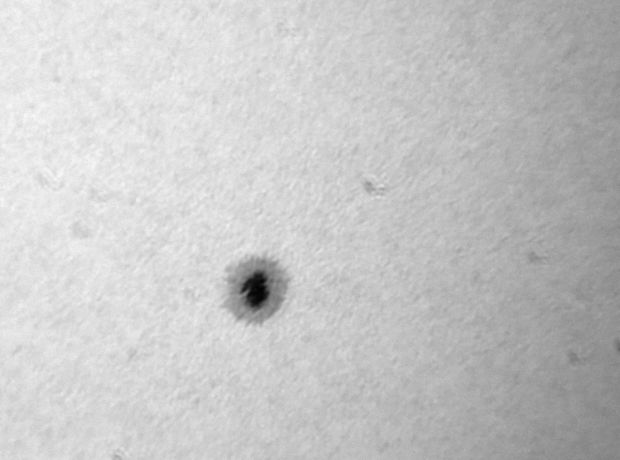 |
A close-up image of spot number 11084. Maybe it is splitting. We will have to see. Date and Time: 4 July 2010, 07:12 UT Camera: DMK 21AF04 Telescope: LX200 at prime focus. Capture: ICCapture. Exposure 1/250 sec, gain 250, 4713 frames Processing: Registax. 150 frames stacked, wavelets 1,2 = 10, histogram 50-185, Focus Magic 4,75 |
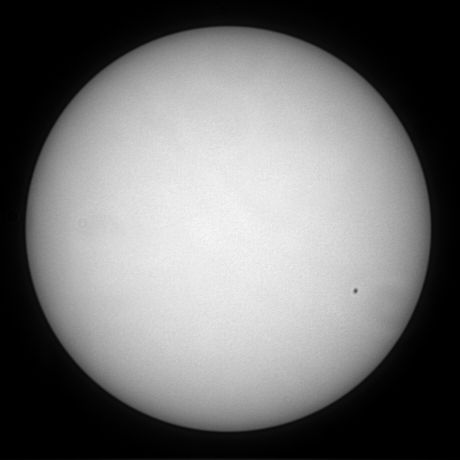
| The Sun imaged the following day. At least the image is the same size as yesterday's. By superimposing this picture on yesterday's I was able to estimate that the spot is at latitude 26° south. The University of Hawaii shows that it is actually at latitude 20° south. I had made a few assumptions in making my estimate (for example the Sun's axis is not perpendicular to the ecliptic, and my telescope is not aligned with the ecliptic either), so I feel I did quite well. Date and Time: 5 July 2010, 11:07 UT Camera: DMK 21AF04 Telescope: 270mm SLR lens at f/5.6 Capture: ICCapture. Exposure 1/154 sec, gain 250, 3375 frames Processing: Registax. 111 frames stacked. Wavelets 1-2 = 5, histogram 10-200 |
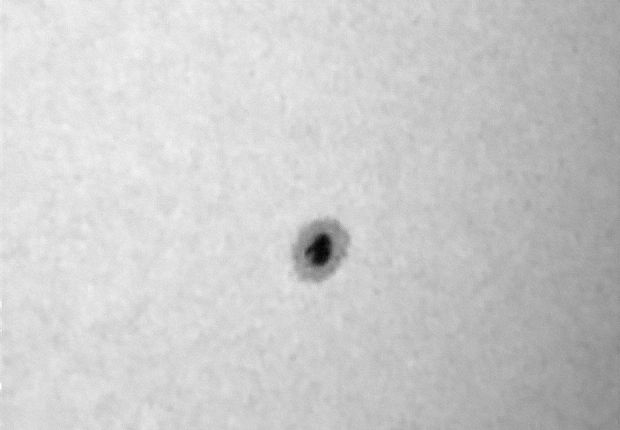 |
A close-up image of spot number 11084. No further sign of its splitting. Date and Time: 5 July 2010, 10:57 UT Camera: DMK 21AF04 Telescope: LX200 at prime focus. Capture: ICCapture. Exposure 1/876 sec, gain 180, 4145 frames Processing: Registax. 89 frames stacked, wavelets 1,2 = 10, histogram 45-200, Focus Magic 7,100 |
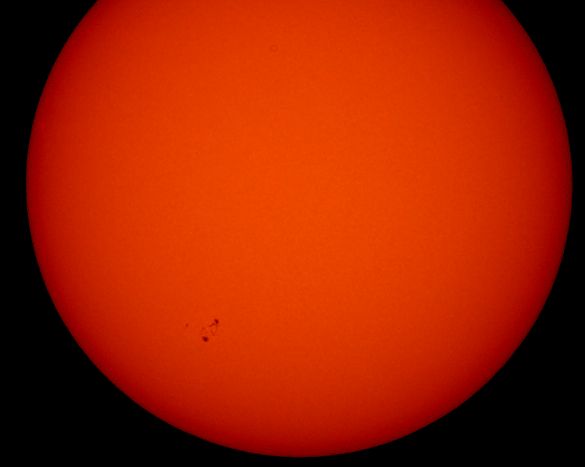
| This is the biggest group I have seen for a very long time. This picture was taken with my Canon 1000D camera at prime focus of my ETX125 with its glass solar filter. Unfortunately the image is just a little too big for the camera. The spot is at latitude 24° south. Date and Time: 23 July 2010, 10:02 UT Camera: Canon 1000D Telescope: ETX125 at prime focus Capture: Exposure 1/500 sec ISO 400 Processing: PhotoImpact. Reduced to 25%, contrast 40, brightness -6 Focus Magic 2,100 |
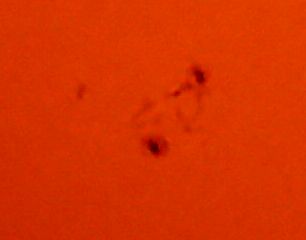 |
A close-up image of spot group 11089. This is cropped from the original of the image above and enhanced as below. Camera: Canon 1000D Telescope: ETX125 at prime focus. Capture: Exposure 1/500 sec ISO 400 Processing: PhotoImpact. Contrast 40, brightness -6 Focus Magic 10,100 |
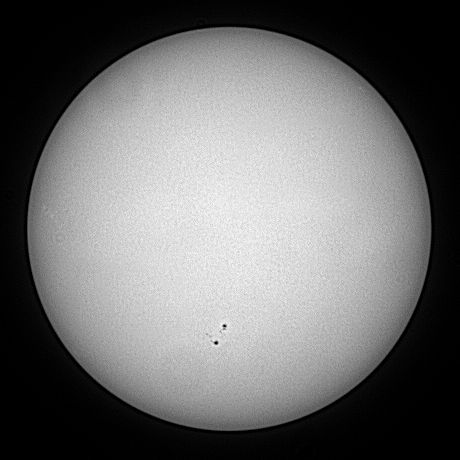
| I took the pictures on 23rd in a hurry as the forecasts predicted cloud for the forseeable future. However Nephele (the Goddess of the clouds) was kind and gave me intermittent clear skies the next day, so I was able to image more conventionally. This is the whole sun showing sunspot group 11089 in the southern hemishere. Date and Time: 24 July 2010, 10:04 UT Camera: DMK 21AF04 Telescope: 270 mm SLR lens Capture: Exposure 1/183 sec, gain 389, 3404 frames Processing: Registax. 133 frames stacked, wavelets 1-2 = 5 Focus Magic 1,100 |
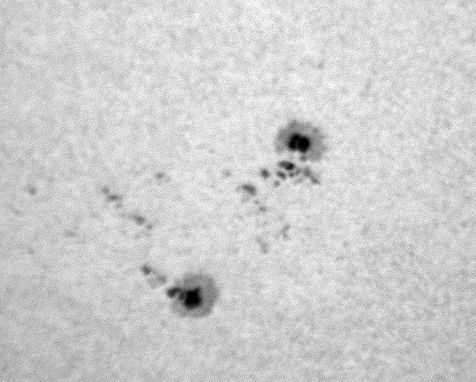 |
This close-up image of spot group 11089 was taken through my LX200 with a full-aperture solar filter. Date and Time: 24 July 2010, 09:24 UT Camera: DMK 21AF04 Telescope: LX200 at prime focus. Capture: Exposure 1/1241 sec, gain 221, 1805 frames Processing: Registax. 103 frames staked, histogram 35-105, wavelet 1-2 = 10 Focus Magic 1,100 |
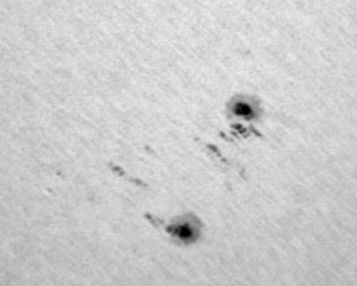 |
And here for comparision is a picture taken using my ETX125. It is smaller because the focal length of the ETX is less than that of the LX200. Date and Time: 24 July 2010, 09:46 UT Camera: DMK 21AF04 Telescope: ETX125 at prime focus. Capture: Exposure 1/500 sec, gain 389, 3438 frames Processing: Registax. 130 frames staked, histogram 70-170, wavelet 1-2 = 10 Focus Magic 1,100 |
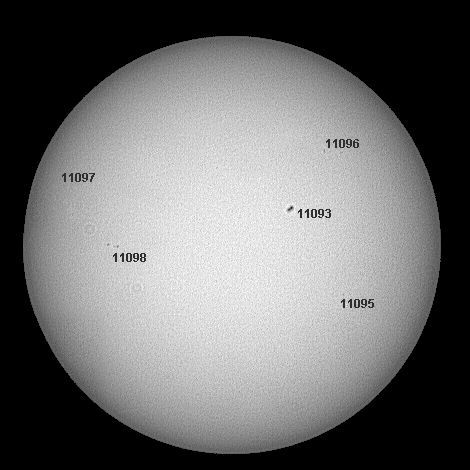
| Lots of spots! Albeit rather small ones. The SOHO site shows all the spots labelled here, but I do not see 11095 or 11097. Date and Time: 11 August 2010, 11:34 UT Camera: DMK 21AF04 Telescope: 270 mm SLR lens Capture: Exposure 1/108 sec, gain 361, 4906 frames Processing: Registax. 130 frames stacked, wavelets 1-2 = 10 Focus Magic 1,100 |
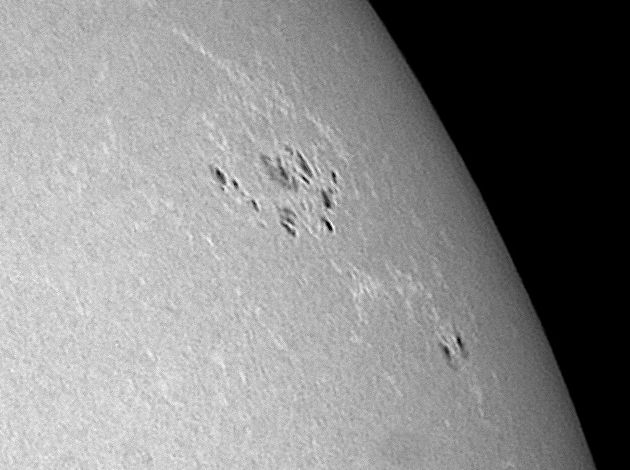
| I was lucky to catch this nice little group between the clouds. It seems to be new and has been given the designation 11099. This is the eastern limb, so it will not be long before the group disappears around it. Conditions were very poor so late in the afternoon. Date and Time: 15 August 2010, 15:19 UT Camera: DMK 21AF04 Telescope: LX200 with full-aperture solar filter Capture: Exposure 1/1241 sec, gain 312, 3454 frames Processing: Registax. 127 frames stacked, histogram 10-180, gamma 0.8, wavelets 1-2 = 10 Focus Magic 4,100 |
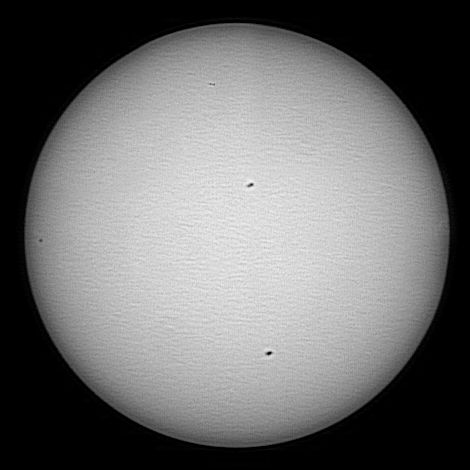
| Three quite small spots were evident. Move your mouse over the image to see their designations. Spot 1115 is at 30° south, 1113 is at 18° north, and 1117 is at 25° north. (There is another spot present, 1118 south-east of 1117, but it is so small that I find it difficult to see even on the SOHO image.) Browse down to see enlarged pictures of each spot. (Two tiny dots north of 1113 are not on the Sun. I am not sure what they are.) These pictures may be the last for this year unless something spectacular happens. The Sun is now so low in the sky that it hardly clears the trees on my southern horizon as seen from my observatory. Date and Time: 20 October 2010, 11:38 UT Camera: Toucam 840K Telescope: 270-mm SLR lens Capture: Exposure 1/500 sec, gain 0%, 312 frames Processing: Registax. 103 frames stacked, wavelets 1-2 = 10, gamma 1.1, histogram 0-130. |
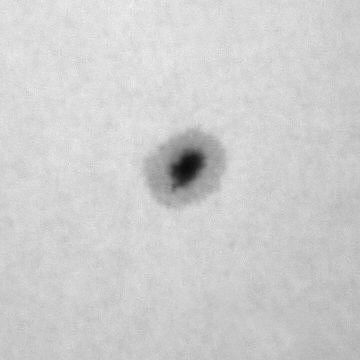
|
Sunspot 1113. Date and Time: 20 October 2010, 11:24 UT Camera: DMK 21AF04 Telescope: LX200 with full-aperture solar filter Capture: Exposure 1/1000 sec, gain 333, 3709 frames Processing: Registax. 180 frames stacked, histogram 70-170, wavelets 1-2 = 10 Focus Magic 1,100 |
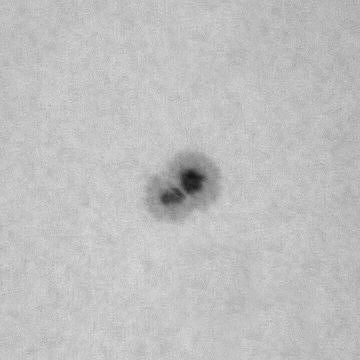
|
Sunspot 1115. Date and Time: 20 October 2010, 11:23 UT Camera: DMK 21AF04 Telescope: LX200 with full-aperture solar filter Capture: Exposure 1/1000 sec, gain 333, 3465 frames Processing: Registax. 100 frames stacked, histogram 90-188, wavelets 1-2 = 10 Focus Magic 1,100 |
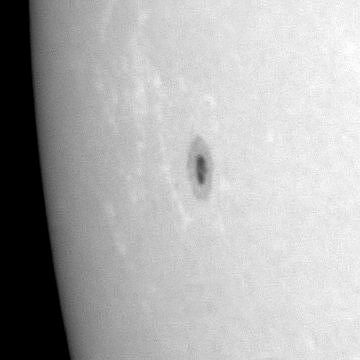
|
Sunspot 1117. Date and Time: 20 October 2010, 11:28 UT Camera: DMK 21AF04 Telescope: LX200 with full-aperture solar filter Capture: Exposure 1/736 sec, gain 333, 3598 frames Processing: Registax. 92 frames stacked, histogram 10-185, wavelets 1-2 = 10, gamma 1.1 Focus Magic 1,100 |